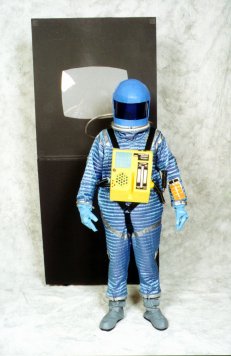
by Ken Warren
The Jump Suit
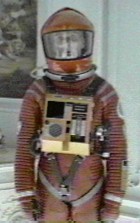 The jump
suit is made primarily of pre-quilted blue nylon - the sort of material
you'd make a jacket or sleeping bag out of. The outer surface was
metallic light blue, with a faint undercurrent of purple (visible in some
of the photographs); the inner lining was matte navy blue. The hip
belts are just duct tape, as are the shoulder reinforcements. The
mission patch on the left shoulder (barely visible) was a graphic
of the original, printed onto iron-on transfer material, ironed onto
reinforced cotton, and sewed to the suit. The helmet insigniae are
the same image, printed on plain paper and glued in place. There
is an American flag on the right shoulder, though one was not present in
the film. The arm control is silver vinyl over craft foam, and the
buttons are also craft foam. The upper-arm and knee connectors are
also silver vinyl over craft foam, with small mirrors glued to them.
There are two conduit connectors on the sides of the front of the suit
which connect to corrugated black hosel the left side connects to the backpack,
the right to the chest pack. The neck piece comes off, and is held
in place with velcro. There is a zipper in the back. The silver
couplings for the gloves, boots and helmet are pairs of embroidery
hoops spray-painted silver and glued in. The gloves, boots and helmet
are removable.
The jump
suit is made primarily of pre-quilted blue nylon - the sort of material
you'd make a jacket or sleeping bag out of. The outer surface was
metallic light blue, with a faint undercurrent of purple (visible in some
of the photographs); the inner lining was matte navy blue. The hip
belts are just duct tape, as are the shoulder reinforcements. The
mission patch on the left shoulder (barely visible) was a graphic
of the original, printed onto iron-on transfer material, ironed onto
reinforced cotton, and sewed to the suit. The helmet insigniae are
the same image, printed on plain paper and glued in place. There
is an American flag on the right shoulder, though one was not present in
the film. The arm control is silver vinyl over craft foam, and the
buttons are also craft foam. The upper-arm and knee connectors are
also silver vinyl over craft foam, with small mirrors glued to them.
There are two conduit connectors on the sides of the front of the suit
which connect to corrugated black hosel the left side connects to the backpack,
the right to the chest pack. The neck piece comes off, and is held
in place with velcro. There is a zipper in the back. The silver
couplings for the gloves, boots and helmet are pairs of embroidery
hoops spray-painted silver and glued in. The gloves, boots and helmet
are removable.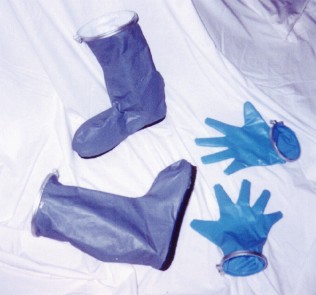
© 2001 G. Anderson
The Gloves and Boots
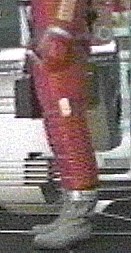 The gloves
are made of blue Pleather®, from a tracing of my hands, sewed on our
sewing machine and inverted. The boots are textured grey vinyl and
flip-flop (shower shoe) soles. The boots were folded over one sole
and glued in place; the second sole was then glued to the outside of the
first one. The rings are embroidery hoop outer rings as described
above.
The gloves
are made of blue Pleather®, from a tracing of my hands, sewed on our
sewing machine and inverted. The boots are textured grey vinyl and
flip-flop (shower shoe) soles. The boots were folded over one sole
and glued in place; the second sole was then glued to the outside of the
first one. The rings are embroidery hoop outer rings as described
above.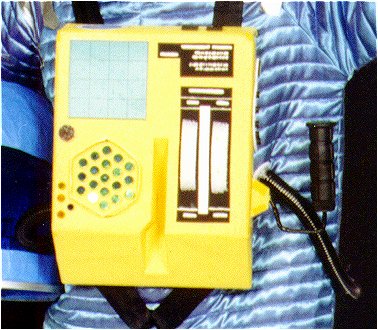
© 2001 Ken Warren
The Chest Pack
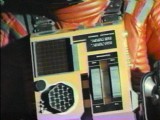 The chest
pack is a cardboard frame covered with yellow poster-board. I was
supposed to use orange, but the source pictures I had captured made it
look yellow (the movie shot above). Oh, well. There is a mission
insignia on the top face, and three square mirrors. The square monitor
section is a piece of a quilting template on green craft foam; the black
panels and white side thingy are craft foam, and the writing is Wite-Out
nonsense. The curved sliders are sections of styrofoam rings.
The knobs and the round elements in the hexagon are all more mirror segments.
You can't quite see the conduit connector on the left of the picture, that
held the corrugated black tubing. The 1.5" black webbing that is
attached to the backpack is held to the pack by hair pins punched through
the cardboard and taped flat. The jet control handle a small paint
roller with a bicycle handle stuck to the end..
The chest
pack is a cardboard frame covered with yellow poster-board. I was
supposed to use orange, but the source pictures I had captured made it
look yellow (the movie shot above). Oh, well. There is a mission
insignia on the top face, and three square mirrors. The square monitor
section is a piece of a quilting template on green craft foam; the black
panels and white side thingy are craft foam, and the writing is Wite-Out
nonsense. The curved sliders are sections of styrofoam rings.
The knobs and the round elements in the hexagon are all more mirror segments.
You can't quite see the conduit connector on the left of the picture, that
held the corrugated black tubing. The 1.5" black webbing that is
attached to the backpack is held to the pack by hair pins punched through
the cardboard and taped flat. The jet control handle a small paint
roller with a bicycle handle stuck to the end..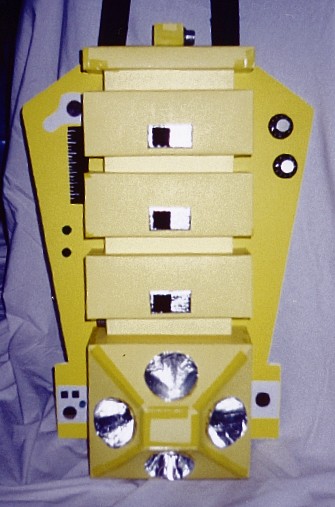
© 2001 G. Anderson
The Back Pack
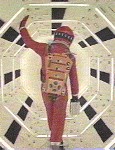 I
abandoned the cardboard understructure for the backpack. The back
panel is foam core; the boxes are all poster board. Yellow electrical
tape holds it together. You can see the air connector at the top
- a clear plastic tube connected that to the helmet. The white and
black elements are craft foam, with mirrors on them. The knobs are
just knobs. The silver things on the main boxes are silver vinyl,
again, mounted over craft foam, with craft foam glued to the outside.
The rocket jets are poster board covered with tin foil and rolled into
a cone. The straps are held to the frame with hair pins. Again,
it should be orange, but I got confused. You might recognize the
other connector between the rocket section and the bottom box on the left,
that attached to the other length of corrugated tubing.
I
abandoned the cardboard understructure for the backpack. The back
panel is foam core; the boxes are all poster board. Yellow electrical
tape holds it together. You can see the air connector at the top
- a clear plastic tube connected that to the helmet. The white and
black elements are craft foam, with mirrors on them. The knobs are
just knobs. The silver things on the main boxes are silver vinyl,
again, mounted over craft foam, with craft foam glued to the outside.
The rocket jets are poster board covered with tin foil and rolled into
a cone. The straps are held to the frame with hair pins. Again,
it should be orange, but I got confused. You might recognize the
other connector between the rocket section and the bottom box on the left,
that attached to the other length of corrugated tubing.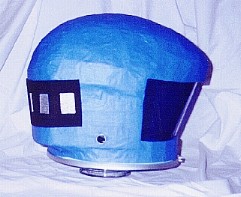
© 2001 G. Anderson
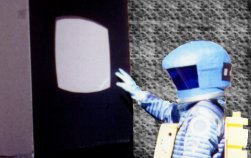
© 2001 D. M. Dubé
The Helmet
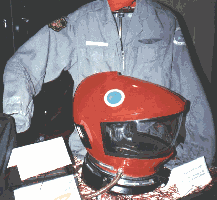 The helmet began
life as an inflatable Easter egg. I made a buckram mold of that for
the top of the helmet, reinforced it with plaster tape (like buckram, only
with plaster), and trimmed it to be the shape of the top. The back,
sides and neck are cardboard. The whole thing is reinforced with
duct tape, and finished with blue masking tape. The shape is wrong
but suggestive of the original. I was originally missing the mission
insigniae on the top, but added them for WorldCon. However, the ridge
on the top was just too much of a pain. The face plate, which had
to be opaque for the stage, is another kind of quilting template.
You can see the air hose connector embedded in the side. The back
module panel is craft foam with holes cut through the entire helmet, and
silver perf paper to cover the holes. These were air holes.
I also punched air holes in the face plate right at the bottom, so they
were basically invisible. The silver ring is attached to the cardboard
with a thin strip of blue vinyl to give it some flexibility for attaching
to the neck of the suit.
The helmet began
life as an inflatable Easter egg. I made a buckram mold of that for
the top of the helmet, reinforced it with plaster tape (like buckram, only
with plaster), and trimmed it to be the shape of the top. The back,
sides and neck are cardboard. The whole thing is reinforced with
duct tape, and finished with blue masking tape. The shape is wrong
but suggestive of the original. I was originally missing the mission
insigniae on the top, but added them for WorldCon. However, the ridge
on the top was just too much of a pain. The face plate, which had
to be opaque for the stage, is another kind of quilting template.
You can see the air hose connector embedded in the side. The back
module panel is craft foam with holes cut through the entire helmet, and
silver perf paper to cover the holes. These were air holes.
I also punched air holes in the face plate right at the bottom, so they
were basically invisible. The silver ring is attached to the cardboard
with a thin strip of blue vinyl to give it some flexibility for attaching
to the neck of the suit.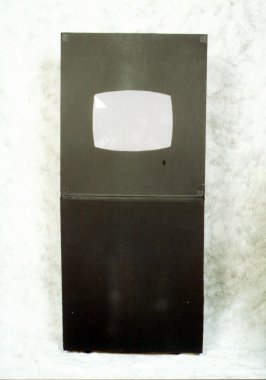
© 2001 Ken Warren
The Monolith
The monolith is a wooden frame made of nearly 80 feet of 2x2 posts. It comes in two sections that attach vertically using hinges and R-clips. Each section also has a shelf - the bottom section's shelf has four castors for wheeling the unit around, and screws to attach a UPS to power the system (we would not expect power to be provided). The shelves also attach using hinges - slide it in place, lock the hinges with R-clips, and it stays. The top shelf is only for stability. There is a cross-beam that sits about 6' up. The outer surface is black-on-black foam core, hot-glued and screwed into place. The screws and the separation between the top and bottom sections are covered by black gaffer's tape (thanks, Mark). The "TV screen" is a cut-out of the foam core, backed with clear plexi-glass, which itself was backed with grey cotton fabric. A black drape hangs over the back to block light leakage. A "Big Ball Of Lite" disco ball is duct taped horizontally to the cross beam to shine directly through the TV opening. A black switch is embedded in the front of the monolith just under the TV, so I could turn the ball on during the presentation.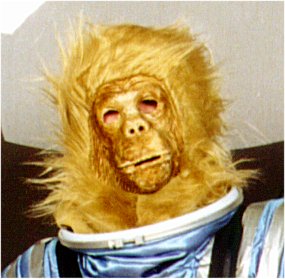
© 2001 Ken Warren
The Gorilla Head
At Balticon, the gorilla mask was part of a commercial full-body gorilla suit. It was made of fake black fur glued to a painted latex head mask. It was lent to me by a friend. For WorldCon, I felt I had to make it myself, so I did.The gorilla head I made was made from liquid latex, molded inside a child's gorilla mask. The skin was colored and mottled with brown shoe polish. The fur was 3"-pile golden-brown faux fur. The neck closed together with Velcro. Nothing was used to hold the mask inside the suit; the lining of the fur and the inside of the latex provided more than enough friction to keep it on my head when the helmet came off.